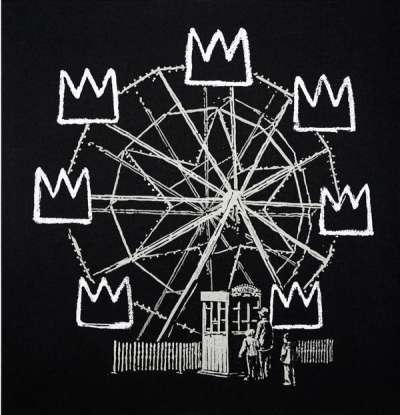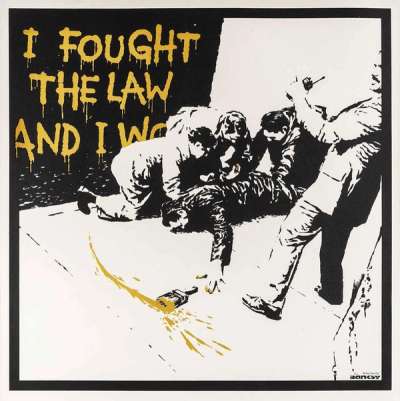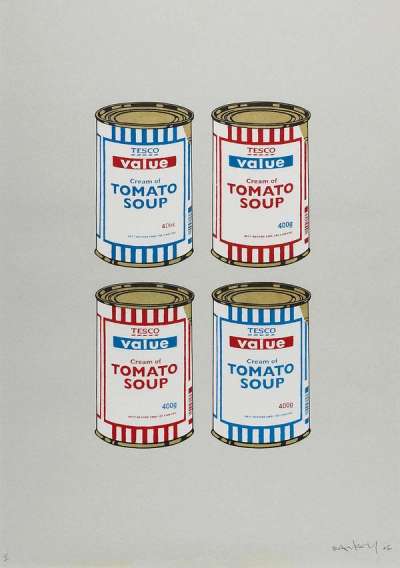Banksy's Sunflowers From Petrol Station

 Sunflowers From Petrol Station © Banksy 2005
Sunflowers From Petrol Station © Banksy 2005
Banksy
268 works
Banksy’s Sunflowers From Petrol Station, painted in 2005, is an arresting oil piece that subverts the vibrant vitality of Vincent Van Gogh’s Sunflowers into a stark commentary on decay and desolation. Unlike the celebrated Dutch master's work, this rendition depicts a wilting bouquet, sparsely populated with petals, against a luminous yellow backdrop. Banksy's is a profound reinterpretation of beauty and its transience, further marked by his autograph on the vase, a nod to artistic legacy and vandalism's interplay. A rare example of the British street artist’s hand-painted oils, this work sheds light on a lesser-known side of his creative practice.
Sunflowers From Petrol Station: Meaning and Analysis
The artist’s signature spray-painted symbols are not to be found in this work, a bold reinvention of Vincent Van Gogh’s Sunflowers. Although the work retains most recognisable features of the original painting, making it immediately present in the viewer’s mind, a sense of deviation is still strong in Banksy’s take on the floral subject matter. The artist exchanges Van Gogh’s lavish bouquet for a bunch of thin, withering flowers, significantly altering the original tone of the painting. Dead petals spread around the vase, showing how the artist puts emphasis on the aspect of decay rather than blooming and life. Rendered in blue letters, the artist’s name appears on the surface of the vase, mimicking Van Gogh’s original gesture. An ornate gold frame further reminds the viewer of classical works.
An important part of the artist’s seminal exhibition ‘Crude Oils: A Gallery of Re-mixed Masterpieces, Vandalism and Vermin’ organised in London in 2005, Sunflowers From Petrol Station captures the boldness of Banksy’s dialogues with tradition. The artist commented in the context of his constant need to reinvent his own work as well as that of the artist before him: “If you want to survive as a graffiti writer when you go indoors your only option is to carry on painting over things that don't belong to you”. Here, Banksy transcends mere imitation, engaging in a visual discourse with the masterpiece. By altering the essence of the original sunflowers, Banksy reflects on the nature of art, its impermanence and the shifting paradigms of value and beauty. This painting is not just an artistic homage, but a potent symbol of the cycle of life and the role of the artist as a commentator, provocateur, and innovator, unafraid to confront tradition with modern realities.
“This piece is a rare glimpse into Banksy's hand-painted works, showcasing his ability to engage with and challenge historical art narratives.”

Banksy and van Gogh: Voices for the Marginalised
In juxtaposing the withered blooms of Sunflowers From Petrol Station with Van Gogh's exuberant works, Banksy can be seen engaging in a silent dialogue with the Dutch master. In any case, both artists address the plight of the marginalised in their respective eras through their art. Van Gogh, who lived in poverty and mental anguish for much of his life, often depicted the lives of the underprivileged, from the downtrodden potato eaters to the lonely figure of a postman and the social isolation of local prostitutes. His paintings, rich with emotional depth and humanity, expressed a deep affinity with those on the outskirts of society. Banksy, centuries later, uses his platform to highlight the contrasts between the forgotten and the celebrated, the decayed and the vibrant, much like Van Gogh did. Through his reimagined Sunflowers, he seems to speak to the commercialisation of art and the neglect of societal woes, a poignant reminder of the issues Van Gogh once depicted with his brush.
Both artists, in their unique ways, have utilised their canvases as megaphones to amplify the issues faced by the marginalised. Banksy’s work, often laced with satire and dark humour, critiques contemporary issues from war to consumerism to the very institution of art itself. His Sunflowers From Petrol Station is often interpreted as a commentary on the environmental decay due to industrialisation—a modern concern that resonates with Van Gogh's sensitivity to the struggles of the rural poor. Van Gogh's commitment to capturing the essence of his subjects, with all their flaws and strengths, granted dignity to those society often overlooked. Banksy, on the other hand, often uses his global fame to spotlight important causes that are underreported on, such as the refugee crisis and the commonality of domestic violence. Both artists, separated by time but united in cause, wield their art as a profound statement on behalf of those without privilege, power, or place.
Sunflowers From Petrol Station: Exhibition History
Crude Oils, London, 2005
Banksy: The Unauthorised Retrospective, S/2 London, curated by Steve Lazarides, 2014











